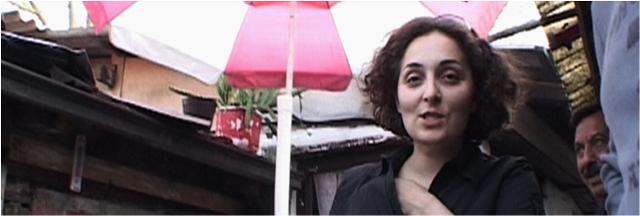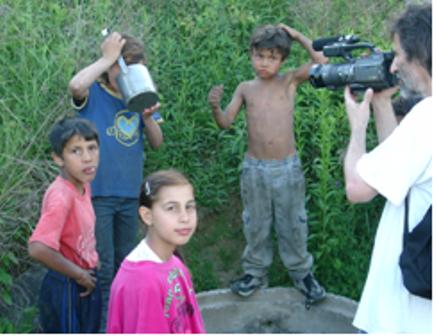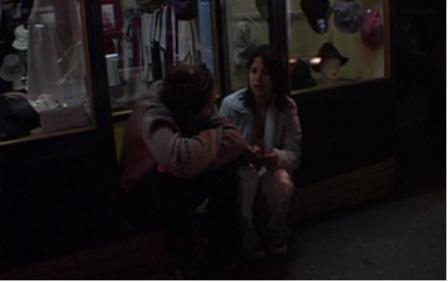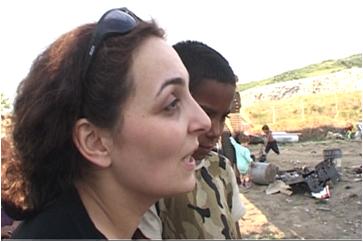Interview with Lidija Mirkovic
 Lidija Mirkovic at the set
Lidija Mirkovic at the set
You don’t look like a Gypsy! I'm Gypsy from my mother's side and very light-skinned. I am taken rather for a Greek. If I tell someone that I'm Gypsy his behavior changes markedly. That's not always pleasant, but sometimes it's very amusing.
What has been your intention with the film? I wanted to create a committed film which doesn't indoctrinate the audience and isn't naive or preachy. It should become a film that makes people visible apart from prevailing views. In the arts and the media Gypsies have always been glorified, praised, admired or vilified. I wanted to show Gypsies who have nothing do with the romanticized clichés or usual stereotypes.
Don’t you take the cliché as well, if you show playing cards in context with Gypsies? You mean the final part in the film? You are right; Gypsies are often linked with playing cards and fortunetelling, for example in the visual arts Gypsies are often portrayed as card sharpener. In the third act of the Opera Carmen the cards play a main role. The cards in my film are meant as an allegory. Nobody knows what will happen to those people. Within each card game there is a kind of show down: the cards are exposed and there are winners and losers. The card game should prepare the viewer for the Iva's defeat.
 Miodrag Misa is filming the children at the standpost
Miodrag Misa is filming the children at the standpost
The prelude of your movie is quite experimental! The history of this passage is much longer than we show it. My editor Jens Lindemann takes the view that we can't expect this situation of the audience any longer without that they turn away from the film. I found the material with Anon very strong and wanted to use it by all means. Originally, I wanted to let the viewers sit in front of a complete black wall, but I lost my courage. In search of a motive, I had the idea with the light in the darkness. When I was sure that I will have it like this, we tried to find something that meets my ideas. This light we shot in a port.
This sounds as if you had a lot of material. How much time has the cut taken? We have shot about 40 hours. The cut have taken very much time, we have a lot of great material. My cameraman Misa Milosevic donated me wonderful pictures. But the complexity of the issue has forced us to rejected new cit versions again and again - until I was satisfied that finitely. I wanted a quick dense film and to this end, Jens Lindemann was a great help, even if his willingness to suffer was much less than mine. But this is something that distinguishes women from men - at least I think so.
Abuses of Roma Rights in Serbiaby the Minority Rights Centre. Since the proclamation of the Decade of Roma Inclusion by some countries of Southeast Europe and various organizations of the UN and the EU many scientific reports have been prepared. I have read the UNICEF report and
 Lidija Mirkovic is having a conservation
on Belgrade's street-walkers' pitch
Lidija Mirkovic is having a conservation
on Belgrade's street-walkers' pitch
How was practice? Before the film I believed knowing the circumstances of Gypsies living in Serbia, I was there and went regularly to relatives. I was certainly never in the Gypsy quarters of Belgrade. We are assimilated Vlach-Roma, my contact with members of other Gypsy groups was quite limited. With some working hypothesis in the luggage we went to Belgrade. What we actually have found it has by far exceeded my ideas, in a negative sense. Overall, we were three times in Belgrade, and had over twenty days of shooting there. That was not planned originally.
The opinion of the experts will come only when the film is finished already. Why? Talking about someone structured the perception of the audience. This I wanted to avoid in this situation, because talking about gypsies is often; they rarely get a chance to speak themselves. Günter Grass called Roma and Sinti correctly as people without a voice. There is always the danger of a paternalism by too much well intended, which does not apply for those two experts here. I did not want to go with quite objective information, putting the statements of two experts at the end seemed a possibility.
How did you feel when you were confronted with Heil Hitler-shouts? It was sort of a lucky chance that the situation has developed in the way like it did. The confrontation of these two men is also a conflict of the Serbian society. This conflict between the left and the right social forces of Serbia characterizes Serbia at least since the occupation by Nazi troops in March 1941. In the resistance, there were the communists and the royalists which waged war against each other too. Under Tito, the political rightists were silenced and did not become socially important. Many people mourn after Tito's time, because the people are better at this time, even the Gypsies. However, one must not forget that the Tito's neutrality efforts and his Third Way have been remunerated with Western loans. Today, Serbia is impoverished and burdened by the huge refugee problem. The political right has captured many hearts and roads. It often leads to rightwing violence, often directed against Gypsies. The justice punishes the abuses and crimes against Roma now, but many proceedings of racist crimes are delayed or the punishments are very mild.
In my hometown for instance Gypsies were forbidden to enter a leisure facility, the operator was also the district chairman of the Radical Party of Serbia. He could do this for several years until the district court sentenced him to apologize to the affected Gypsies affected by newspaper notice. NGOs set the proceedings rolling; local authorities tolerated the behavior of Krsmanovic for years.
Is Prostitution actually a problem in the Gypsy society? Since the 1990s the prostitution of women, girls and children all over Eastern Europe has increased dramatically. To my knowledge in the Belgrade city centre there is a children's line, where six year old boys are offered for sexual services, where young girls like Zaklina prostitute them. Frequently, this income of children and women goes for the alimentation of the family.
Do you see Carmen as a prostitute? In one sequence, the 15-year-old prostitute Zaklina is introduced, the contextual relevance of this sequence is expanded by the reference to Carmen. Taking into account the social situation of Gypsies usually live in, then you can see in Carmen a prostitute. The image of Carmen is one of the major stereotypes that are noised about Gypsies. Remember that Gypsies in art and literature are represented and portrayed for centuries by Gadjos, means non-Gypsies.
On literary precursors of Carmen is called The Gypsy Girl by Miguel de Cervantes of the early 17th century and Notre Dame de Paris by Victor Hugo of the centre beginning of 19th century. Prosper Mérimée published the novella Carmen 1845. For his opera Carmen premiered in Paris in 1875, Bizet let rewrite this story by Henri Meilhac and Ludovic Halévy. Carmen is one of the most successful operas of the world. In this opera the mental pictures of the Gypsies are effective which exist for centuries.
Can one really claim that prejudices from the Middle Ages still have validity? Attributes that the Gypsies had been assigned to already in the Middle Ages are still in fact, look at the events in Italy in May 2008.
The attacks on the Gypsy slums have been triggered because a Gypsy woman should have supposedly stolen the baby of an Italian. The charge of children robbery is already raised since the Middle Ages. By the way, the Jewish fellow citizens were faced with the same charge.
How did you find Ivanka? After our first main protagonist Hermione dropped out, we have first worked with several protagonists. In the months in which we have accompanied the demo, it has emerged that it is Iva, which we want to have for the film. We have worked with her by the point in time when she lost their residence status and was staying illegally in Germany. The contact we have kept up. The situation was hard to take for her and her family. I found it inappropriate to accompany her cinematically under the conditions of illegality.
Rich and poor, a subject in Düsseldorf and Belgrade? I tried to find images in both cities, which can serve as metaphors or symbols. I have seek for parallels and contrasts in these two cities. Much of it was just luck, for instance the two children making music on the street and playing a very broken variation of the Gypsies National Anthem Romany.
The development of Gypsy children in Belgrade seems predetermined. The girl in Belgrade selling the postcards in street cafes is a reference to the coming sequence with the young prostitute Zaklina who worked also as a street vendor when she was a child and before started prostituting. The shootings with Gypsy children create suspense to the images that we have found of children of the white majority of the society. Looking at the key figures on unemployment, education, etc. and also the increasing nationalism in Serbia, the idea is daring that these children will have a civilian job some day. Here I can only refer to the reports and investigations of the various humanitarian organizations which get involved more and more with.
 Lidija Mirkovic on the dump Vinca
Lidija Mirkovic on the dump Vinca
Life on the dump is rather an exceptional situation, isn’t it? The film I have dreamed of working as a hairdresser is not a film about Serbia, but it is a film about the situation and the experiences of Gypsies in Eastern Europe. If you read the studies by UNICEF, UNHCR, and so on, you can see that Serbia is only an example for those countries. Life on dump is certainly not the rule, but you can find these and similar circumstances at all major landfills in Eastern Europe. And you can always find Gypsies there. One of the reports by UNICEF says that about 20 % of all Gypsies in Eastern Europe live on the evaluation of secondary raw materials. Of course, not all of them are living on the garbage dumps, but they live on the garbage evaluation.
How should I see it? Do the people actually eat from the garbage? Food whose date of expiry is exceeded are brought to the disposal, and the people dig it out again, they consume it or pass it on. Partially leftover food of others or died animals are eaten. Or they catch the seagulls you see everywhere on the dump, they have several techniques for that. They prepare them as roast chicken. You may get used to the thought that this situation is everyday life. It is maybe unimaginable, but unfortunately it is like this. We have a situation similar to the Third World just around the corner, whether we like it or not.
What is your opinion? Are Roma and Sinti nomads? There are groups of Gypsies who wander about. An ethnologist would possibly describe them as nomads. Right now only the Cergari come into my mind. But most Gypsies – that's my opinion – are settled. They leave their traditional places only when they have to.
Take, for example, the Gypsies from Portugal, a country in a bad economic situation. As citizens of the European Union (EU) Gypsies could settle into any economically better-off EU member state. This has not happened, although Gypsies also live in extreme poverty. For me, this behavior that one finds elsewhere is an indication that Gypsies are primarily sedentary. If and only if political tensions are added to the economic hardship, they decide to seek a new place where they want to settle down once more. You can observe this in the Gypsy migration that has started in the 1990ies in Eastern Europe and still continues.
What was the reason for you to start with the film? Germany and especially North Rhine-Westphalia became the scene of a demonstration of about 600 Roma who travelled across Germany in a motorcade to demonstrate against their upcoming deportation. The demonstration made it easier to find the right actors and enabled a trustfully communication with affected persons. This would be impossible for example in the context of an asylum home or in private homes, since Gypsies are very shy in such matters. Presenting oneself or acting as a Gypsy is very embarrassing for many of them because most of them hide this from their neighbors' but also from close friends.
But this demonstration was a wonderful place to show the nowhere where the Gypsies are in and live. They are not nomads, but they are really at home nowhere because they are really accepted nowhere.
Why did you let repeat the radio news? I have asked the local radio station in Düsseldorf whether I could get their messages on this demonstration. Unfortunately, they archive them for only a very short time. So I have fallen back on the local newspaper Rheinische Post, whose publisher is indirectly the main owner of this radio station. I didn't want to correct the errors that were included in these reports. I wanted to provide it as it is has been perceived by the media.
How satisfied are you with your work? This is my first long film. I aimed at a entertaining committed film without stressing the interested audience. I hope I have succeeded. I hope that from the abundance of the material a condensed and hopefully exciting narrated film was developed, although is biased, ut still keeps a critical distance to its protagonist. I am very happy that the Film Foundation North Rhine-Westphalia has supported my film.
 Miodrag Milosovic - Misa, Lidija Mirkovic,
Markus Westphalen and Dzoni Sichelschmidt
Miodrag Milosovic - Misa, Lidija Mirkovic,
Markus Westphalen and Dzoni Sichelschmidt